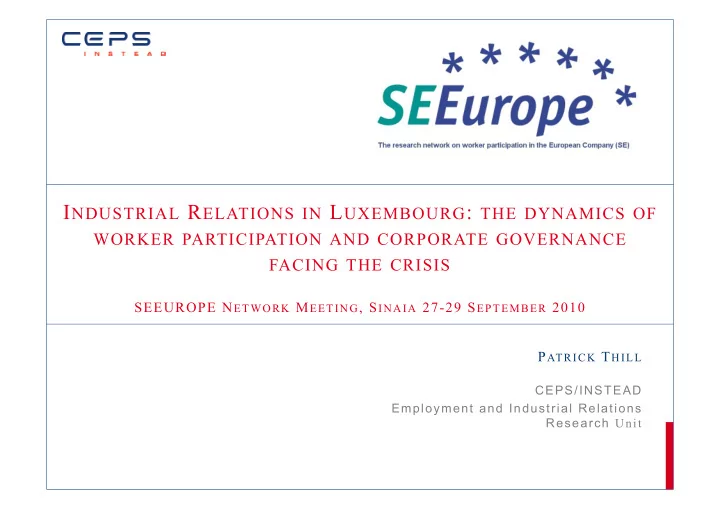

I NDUSTRIAL R ELATIONS IN L UXEMBOURG : THE DYNAMICS OF WORKER PARTICIPATION AND CORPORATE GOVERNANCE FACING THE CRISIS SEEUROPE N ETWORK M EETING , S INAIA 27-29 S EPTEMBER 2010 P ATRICK T HILL CEPS/INSTEAD Employment and Industrial Relations Research Unit
I NDUSTRIAL R ELATIONS IN L UXEMBOURG : THE DYNAMICS OF WORKER PARTICIPATION AND COPORATE GOVERNANCE 2 FAVING THE CRISIS S TRUCTURE 1. Luxembourg facing the crisis 2. The general framework of industrial relations in Luxembourg 3. The transposition of SE legislation: general remarks 4. Case studies and possible drivers 5. General discussion
I NDUSTRIAL R ELATIONS IN L UXEMBOURG : THE DYNAMICS OF WORKER PARTICIPATION AND COPORATE 3 GOVERNANCE FAVING THE CRISIS LUXEMBOURG FACING THE CRISIS Key features • Increase of unemployment (6,1%) • Budgetary deficit • Part-time employment measures for companies • Increase of cases of company restructuring (i.e. Villeroy&Bosch) • Social tensions (marches…) Reaction • Rescue plan for major banks • Economic stimulus package (2008-2009) • Austerity measures (i.e. crisis tax, increase of solidarity tax…) • Diverging positions: Trade unions (indexation) vs. Employers’ unions (competitiveness, wages) vs. Government (compromise or unilateral action)
4 T HE TRANSPOSITION OF SE LEGISLATION T HE GENERAL FRAMEWORK OF INDUSTRIAL RELATIONS IN L UXEMBOURG General characteristics • Pluralistic trade union structure • High degree of unionisation • Three main unions: OGB-L (socialist: 60.000), LCGB (Christian-conservative: 40.000), CGFP (civil servants: 28.000) • Sectoral federations (i.e. OGB-L 15 affiliated associations) • Strong union implication in the national decision-making process (i.e. through assessments, tripartite meeting, through the Economic and Social Council…) • Implication of trade unions in the Special Negotiating Body (SNB) • Large coverage of collective agreements (3 types of agreements)
I NDUSTRIAL R ELATIONS IN L UXEMBOURG : THE DYNAMICS OF WORKER PARTICIPATION AND COPORATE GOVERNANCE 5 FAVING THE CRISIS T HE GENERAL FRAMEWORK OF INDUSTRIAL RELATIONS IN L UXEMBOURG • Legal framework concerning worker participation: employee committees (1974), employee members of the joint works committees (1974), collective agreements (2004), European worker councils (2000), commercial law (1915) • Creation of neo-corporatist instruments (i.e. Tripartite Coordination committee in 1977, Economic and Social Committee…): trade unions, employers’ unions and government • Origin: steel crisis and the transition from industry-based economy to an economy based on the predominance of the financial sector (currently under pressure)
I NDUSTRIAL R ELATIONS IN L UXEMBOURG : THE DYNAMICS OF WORKER PARTICIPATION AND COPORATE GOVERNANCE 6 FAVING THE CRISIS T HE GENERAL FRAMEWORK OF INDUSTRIAL RELATIONS IN L UXEMBOURG • Bargaining process in a national arena of dialogue and partnership between the government and the social partners with decision-making done by consensus • Agreements whose substance is then carved into national law • Consensus-orientated model of industrial/social relations (currently under pressure)
I NDUSTRIAL R ELATIONS IN L UXEMBOURG : THE DYNAMICS OF WORKER PARTICIPATION AND COPORATE GOVERNANCE 7 FAVING THE CRISIS T HE TRANSPOSITION OF SE LEGISLATION General remarks • In spite of a vital interest (government) to attract foreign companies, SE legislation was only transposed in 2006 • Some SE companies existed prior to the legislation (no employee participation) • Government: SE legislation was regarded as a logical continuation of already existing laws on worker participation, no legal innovations and concepts • Idea of a modernization of social dialogue and commercial law (SE draft bill simultaneously changed the existing legal framework) • No public debate, but: debate took place through assessments by the social partners and the professional associations (2004-2006), leading to a new version of the draft bill
I NDUSTRIAL R ELATIONS IN L UXEMBOURG : THE DYNAMICS OF WORKER PARTICIPATION AND COPORATE GOVERNANCE 8 FAVING THE CRISIS T HE TRANSPOSITION OF SE LEGISLATION • State Council: clear separation between SE law and a general modernization of existing legal framework • Members of the SNB are elected among members of the employee committees (elected by employees or trade unions) • Professional associations opted for a revision of the 1974 law, providing the choice between one-tier and a two-tier management system (SE bill extended this option to limited-liability companies) • Majority of “UFO/Empty SE” (scarcity of information), monistic system of management prevails • “Normal” companies are active international companies, with offices in neighbouring countries (Germany, France or Belgium) • Major activities of SE companies: finance, chemicals, health products, insurance
I NDUSTRIAL R ELATIONS IN L UXEMBOURG : THE DYNAMICS OF WORKER PARTICIPATION AND COPORATE GOVERNANCE 9 FAVING THE CRISIS CASE STUDIES AND POSSIBLE DRIVERS (BEYOND “EUROPEAN IMAGE”) Case studies • Two very opposite examples of SE companies: Elcoteq (Metal, normal, one-tier, international, open as to information policy, model SE) and Algest (Empty, one-tier, regional, scarce information only available through the official register of companies) Possible drivers • Elcoteq: “competitiveness”, “strong, pan-European identity”, “stronger means of identification”, “reputation as a pioneer” • SE companies must accept the long tradition of social dialogue and worker participation • Tangible drivers: Tax reductions, risk management, credit insurance, governmental support (i.e. Office du Ducroire, Société Nationale de Crédit et d’Investissement, support for investments into R&D) for those few active companies
I NDUSTRIAL R ELATIONS IN L UXEMBOURG : THE DYNAMICS OF WORKER PARTICIPATION AND COPORATE 10 GOVERNANCE FAVING THE CRISIS CASE STUDIES AND POSSIBLE DRIVERS (BEYOND “EUROPEAN IMAGE”) • Strong partnership between business and governmental actors, straight access to government (smallness) • Belief in decision-making by consensus • Regional aspect: closeness to neighbouring countries (“the Greater Region driver”), but also the opportunity for Luxembourg companies to merge with neighbouring companies (i.e. Algest SE) • Home to more traditional international companies (SES, Arcelor, Cargolux, Goodyear...): they accepted the rules of social dialogue (force of attraction) • Government promotion campaign (Amazon, Google...) • Link to economic diversification and new emerging sector of activity (insurance, IT and health sectors)
11 Thank you for your attention!
Recommend
More recommend